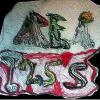Adolescent neck and shoulder pain--the association with depression, physical activity, screen-based activities, and use of health care services.
Is shoulder pain for three months or longer correlated with depression, anxiety, and sleep disturbance?
Is there a link between pain and depression? Can depression cause physical pain?
Moclobemide
- nausea and vomiting (obviously)
- myoclonic jerks in upper extremities
- extreme overdoses: muscle rigidity, and pain, together with rhabdomyolysis
Acute Effects of Sceletium tortuosum (Kanna/Zembrin), a Dual 5-HT Reuptake and PDE4 Inhibitor, in the Human Amygdala and its Connection to the Hypothalamus
The mechanisms of action on the central nervous system (CNS) of a standardized extract of S. tortuosum (Zembrin) were recently identified as comprising blockade of the serotonin (5-HT) transporter and selective inhibition of the phosphodiesterase-4 (PDE4) enzyme
A consistent challenge in translating these pre-clinical studies of PDE4s into clinical practice has been the side effects (Duman et al, 1999); in particular nausea and vomiting (Rock et al, 2009). The combination of SSRIs and PDE4 inhibitors might therefore not only have synergistic therapeutic potential but may allow for lower PDE4 doses that are better tolerated.
------------------------------------
nausea, a common side effect of SSRI therapy, most likely results from stimulation of 5-HT3 receptors and can usually be alleviated by reducing the dose of the SSRI.10 In contrast, fluoxetine-induced skin reactions are not dose related and apparently are idiosyncratic.
Nausea and Vomiting Associated With Selective Serotonin Reuptake Inhibitors: Incidence, Mechanisms and Management
Nausea and vomiting are common adverse effects of therapeutic drugs. Such symptoms are more often due to CNS effects than to direct toxic effects on the gastrointestinal tract (GIT). Drugs may cross the blood-brain barrier and activate the chemoreceptor trigger zone in the brainstem, which contains cells that are responsive to cholinergic, dopaminergic and serotonergic stimulation.
Selective serotonin (5-hydroxytryptamine; 5-HT) reuptake inhibitors (SSRIs) are effective and well tolerated in the treatment of major affective disorders, but their usefulness is sometimes limited by adverse effects, particularly gastrointestinal effects. SSRIs exert their beneficial effects in depressive syndromes by increasing brain serotonin levels. They also increase serotonin levels in other tissues, particularly the GIT, which contains 90% of the body’s store of serotonin and large numbers of serotonin-responsive cells. Increased serotonergic neurotransmission causes anorexia, nausea, vomiting and diarrhoea in other settings, such as carcinoid syndrome, so gastrointestinal adverse effects are not unexpected with drugs that increase tissue serotonin levels. SSRI-induced nausea and vomiting are probably due to effects on the GIT as well as on the CNS.
There are complex interactions between serotonin receptor subtypes. Drugs antagonising one receptor subtype may act as agonists at another receptor. The pharmacotherapy of SSRI-induced nausea and vomiting requires an understanding of the actions and interactions of these receptors and their agonists/antagonists. The most effective drug for the treatment of SSRI-related adverse effects on the GIT is ondansetron, a serotonin 5-HT3 receptor antagonist that blocks the effects of serotonin in the brain and GIT. However, this drug has a high acquisition cost. Thus, the drug of choice may be cisapride which, although a weak 5-HT3 receptor antagonist, has the potential to reduce or abolish SSRI-induced nausea. Many patients with mild adverse effects will not require specific pharmacotherapy, as the nausea tends to abate with prolonged treatment with SSRIs because of gradual desensitisation of 5-HT3 receptors.
A randomized, double-blind trial of 2.5 mg and 5 mg vortioxetine (Lu AA21004) versus placebo for 8 weeks in adults with major depressive disorder
Vortioxetine (Lu AA21004) is an investigational antidepressant. In vitro studies indicate that vortioxetine is a 5-HT3, 5-HT7, and 5-HT1D receptor antagonist, 5-HT1B receptor partial agonist, 5-HT1A receptor agonist and inhibitor of the 5-HT transporter. This trial assessed the efficacy and tolerability of 2.5 and 5 mg vortioxetine for the treatment of MDD.
Tianeptine: a review of its use in depressive disorders.
Tianeptine is an antidepressant agent with a novel neurochemical profile. It increases serotonin (5-hydroxytryptamine; 5-HT) uptake in the brain (in contrast with most antidepressant agents) and reduces stress-induced atrophy of neuronal dendrites. Like the selective serotonin reuptake inhibitors (SSRIs) and in contrast with most tricyclic antidepressant agents, tianeptine does not appear to be associated with adverse cognitive, psychomotor, sleep, cardiovascular or bodyweight effects and has a low propensity for abuse. Tianeptine has a comparatively favourable pharmacokinetic profile. It is not subject to first-pass hepatic metabolism, has high bioavailability and limited distribution, and is rapidly eliminated. While this offers advantages for tianeptine over the tricyclic antidepressant agents in terms of dose titration, treatment changes and potential drug interactions, its rapid elimination makes adherence to dosage schedules more important. Tianeptine differs from most antidepressants in that it is not primarily metabolised by the hepatic cytochrome P450 system, indicating less likelihood of drug-drug interactions; this is of particular interest for elderly patients. Tianeptine, in dosages of 25 to 50 mg/day, has been investigated in patients with major depression, depressed bipolar disorder, dysthymia or adjustment disorder. It has equivalent antidepressant efficacy to several classical antidepressant agents (amitriptyline, clomipramine, imipramine, mianserin) and the SSRIs fluoxetine (in most patients), paroxetine and sertraline. Comparison with maprotiline indicated superior efficacy for tianeptine but dothiepin appeared superior in another study. Extended treatment with tianeptine decreases the incidence of relapse/recurrence of depression. Tianeptine appears to be as effective as fluoxetine, sertraline, amitriptyline, clomipramine and mianserin and more effective than maprotiline in improving associated anxiety in patients with depressive disorders. Depression and anxiety symptoms in alcohol dependant patients also respond well to tianeptine. The adverse effects associated with tianeptine are similar in many respects to those of the SSRIs and minimal in comparison with the tricyclic antidepressants. The most common adverse effects are nausea, constipation, abdominal pain, headache, dizziness and changes in dreaming. Anticholinergic effects occur less often with tianeptine than with tricyclic agents. Hepatoxicity is rare. The dosage should be decreased in elderly patients and those with severe renal failure, but adjustment is not necessary in patients with alcoholism or hepatic impairment, or those undergoing haemodialysis.
Moclobemide: therapeutic use and clinical studies.
Moclobemide is a reversible inhibitor of monoamine-oxidase-A (RIMA) and has been extensively evaluated in the treatment of a wide spectrum of depressive disorders and less extensively studied in anxiety disorders. Nearly all meta-analyses and most comparative studies indicated that in the acute management of depression this drug is more efficacious than placebo and as efficacious as tricyclic (or some heterocyclic) antidepressants or selective serotonin reuptake inhibitors (SSRIs). There is a growing evidence that moclobemide is not inferior to other antidepressants in the treatment of subtypes of depression, such as dysthymia, endogenous (unipolar and bipolar), reactive, atypical, agitated, and retarded depression as with other antidepressants limited evidence suggests that moclobemide has consistent long-term efficacy. However, more controlled studies addressing this issue are needed. For patients with bipolar depression the risk of developing mania seems to be not higher with moclobemide than with other antidepressants. The effective therapeutic dose range for moclobemide in most acute phase trials was 300 to 600 mg, divided in 2 to 3 doses. While one controlled trial and one long-term open-label study found moclobemide to be efficacious in social phobia, three controlled trials subsequently revealed either no effect or less robust effects with the tendency of higher doses (600 - 900 mg/d) to be more efficacious. Two comparative trials demonstrated moclobemide to be as efficacious as fluoxetine or clomipramine in patients suffering from panic disorder. Placebo-controlled trials in this indication are, however, still lacking. A relationship between the plasma concentration of moclobemide and its therapeutic efficacy is not apparent but a positive correlation with adverse events has been found. Dizziness, nausea and insomnia occurred more frequently on moclobemide than on placebo. Due to negligible anticholinergic and antihistaminic actions, moclobemide has been better tolerated than tri- or heterocyclic antidepressants. Gastrointestinal side effects and, especially, sexual dysfunction were much less frequent with moclobemide than with SSRIs. Unlike irreversible MAO-inhibitors, moclobemide has a negligible propensity to induce hypertensive crisis after ingestion of tyramine-rich food ("cheese-reaction"). Therefore, dietary restrictions are not as strict. However, with moclobemide doses above 900 mg/d the risk of interaction with ingested tyramine might become clinically relevant. After multiple dosing the oral bioavailability of moclobemide reaches almost 100%. At therapeutic doses, moclobemide lacks significant negative effects on psychomotor performance, cognitive function or cardiovascular system. Due to the relative freedom from these side effects, moclobemide is particularly attractive in the treatment of elderly patients. Moclobemide is a substrate of CYP2C19. Although it acts as an inhibitor of CYP1A2, CYP2C19, and CYP2D6, relatively few clinically important drug interactions involving moclobemide have been reported. It is relatively safe even in overdose. The drug has a short plasma elimination half-life that allows switching to an alternative agent within 24 h. Since it is well tolerated, therapeutic doses can often be reached rapidly upon onset of treatment. Steady-state plasma levels are reached approximately at one week following dose adjustment. Patients with renal dysfunction require no dose reduction in contrast to patients with severe hepatic impairment. Cases of refractory depression might improve with a combination of moclobemide with other antidepressants, such as clomipramine or a SSRI. Since this combination has rarely been associated with a potentially lethal serotonin syndrome, it requires lower entry doses, a slower dose titration and a more careful monitoring of patients. Combination therapy with moclobemide and other serotonergic agents, or opioids, should be undertaken with caution, although no serious adverse events have been published with therapeutic doses of moclobemide to date. On the basis of animal data the combined use of moclobemide with pethidine or dextropropoxyphene should be avoided. There is no evidence that moclobemide would increase body weight or produce seizures. Some preclinical data suggest that moclobemide may have anticonvulsant property.
Safety of selegiline (deprenyl) in the treatment of Parkinson's disease.
Selegiline (deprenyl), a selective, irreversible inhibitor of monoamine oxidase type B (MAO-B) is widely used in the treatment of Parkinson's disease. As the first MAO-B inhibitor approved for the treatment of Parkinson's disease, concerns were raised about the safety of the drug based on the adverse effect profiles of older, nonselective MAO inhibitors. Unlike the nonselective MAO inhibitors, selegiline does not significantly potentiate tyramine-induced hypertension (the 'cheese effect') at the dosages (5 to 10 mg daily) used for the treatment of Parkinson's disease. Selegiline has been well tolerated when given alone. The most frequent adverse events seen during monotherapy have been insomnia, nausea, benign cardiac arrhythmias, dizziness and headache. When combined with levodopa, selegiline can potentiate the typical adverse effects of levodopa, if the dose of levodopa is not reduced sufficiently. Thus, the most common adverse effects associated with this combination are nausea, dizziness, fatigue, constipation and insomnia. At the later stages of Parkinson's disease when fluctuations in disability occur, peak dose dyskinesias, psychiatric complications like hallucinations and insomnia, and orthostatic hypotension are further potentiated by selegiline. Mortality was recently reported to be increased when selegiline and levodopa were given together in comparison with treatment with levodopa alone, but a large meta-analysis of 5 long term studies and 4 separate studies did not support this conclusion. Selegiline seems to be generally well tolerated in combination with other drugs. However, when pethidine (meperidine) has been given to patients who are receiving selegiline therapy, severe adverse effects have been reported. Thus, the concomitant use of these drugs is not recommended. A low tyramine diet is recommended if selegiline is used together with nonselective MAO inhibitors or the selective, reversible MAO-A inhibitor, moclobemide. Several adverse effects have been reported when fluoxetine and selegiline have been used together. A recent survey revealed that the incidence of a true serotonin syndrome is, however, very low with this combination. Concomitant use of selegiline and other selective serotonin (5-hydroxytryptamine; 5-HT) reuptake inhibitors (SSRIs) like citalopram, which have generally less interactions than fluoxetine, seems to be well tolerated. Nevertheless, caution is advised when combining a SSRI or a tricyclic antidepressant and selegiline.
(-)-Deprenyl, a selective MAO-B inhibitor, with apoptotic and anti-apoptotic properties.
(-)-Deprenyl (selegiline) is an irreversible inhibitor of monoamine oxidase (MAO) B, which was discovered in 1962 and become the "golden standard" of MAO research. Like the other MAO-B inhibitors, it was synthesized as an antidepressant, but in a selective MAO-B inhibitory dose it does not act in depression. It is used in the treatment of Parkinson's disease. (-)-Deprenyl potentiates the effect of dopamine, it has antioxidant activity and prevents the toxicity of the dopaminergic (6-OH-dopamine; 1-methyl-4-phenyl-1,2,3,6-tetrahydro-pyridine (MPTP)), the noradrenergic (DSP-4) and cholinergic (AF64A) neurotoxins after pre-treatment. When (-)-deprenyl was administered with levodopa in a long-term treatment of Parkinsonian patients, it induces adverse events (nausea, dizziness, confusion, hallucination, insomnia and cardiovascular changes), which could be due to dopamine potentiation in dopaminergic systems (limbic system), other than the nigrostriatal pathway. (-)-Deprenyl in much lower concentrations needed to induce MAO-B inhibition (10(-9) to 10(-13) M) potently inhibits MPTP or serum withdrawal induced apoptosis in tissue cultures of neuro-ectodermal origin (PC12, M1, M2058). The (+)-enantiomer of deprenyl lacks of this property. The anti-apoptotic activity of (-)-deprenyl can be prevented by inhibiting the metabolism of the drug with SKF-525A pre-treatment, which suggests that some of the presently unknown metabolites could be responsible for the anti-apoptotic activity. In high concentration (10(-3) M), (-)-deprenyl and its metabolites induce apoptosis in tissue cultures without serum withdrawal (biphasic action). Our findings support the view that 100, or even 1000 times lower dose of (-)-deprenyl can be offered in human therapy to protect, or slow down neuronal degeneration, than it is presently used. With low dose of the drug the dopaminergic adverse events could be avoided, while anti-apoptotic activity might be preserved.
= parkinsonism + high tyrosine diet???
------------------------------------
BANISTEROPSIS CAAPI
------------------------------------
http://www.longecity...onin-receptors/
Platelet serotonin uptake sites increased in drinkers of ayahuasca.
The binding of [3H]citalopram to the platelet 5-hydroxytryptamine (5-HT) transporter was measured in a group of healthy male drinkers of ayahuasca, a psychoactive sacrament indigenous to Amazonia, and a group healthy male controls. An increased number of binding sites (Bmax) in the platelets of ayahuasca drinkers was found, while the dissociation constant (Kd) remained the same for both groups. If indicative of neuronal 5-HT uptake activity, these results would suggest a decreased concentration of extracellular 5-HT, or a response to increased production and release of 5-HT. Such changes in 5-HT synaptic activity, in this case, should not be misinterpreted as an indication of developing neurological or psychiatric illness.
Pharmacokinetics of Hoasca alkaloids in healthy humans.
N,N-Dimethyltryptamine (DMT), harmine, harmaline and tetrahydroharmine (THH) are the characteristic alkaloids found in Amazonian sacraments known as hoasca, ayahuasca, and yajè. Such beverages are characterized by the presence of these three harmala alkaloids, where harmine and harmaline reversibly inhibit monoamine oxidase A (MAO-A) while tetrahydroharmine weakly inhibits the uptake of serotonin. Together, both actions increase central and peripheral serotonergic activity while facilitating the psychoactivity of DMT. Though the use of such 'teas' has be known to western science for over 100 years, little is known of their pharmacokinetics. In this study, hoasca was prepared and administered in a ceremonial context. All four alkaloids were measured in the tea and in the plasma of 15 volunteers, subsequent to the ingestion of 2 ml hoasca/kg body weight, using gas (GC) and high pressure liquid chromatographic (HPLC) methods. Pharmacokinetic parameters were calculated and peak times of psychoactivity coincided with high alkaloid concentrations, particularly DMT which had an average Tmax of 107.5 +/- 32.5 min. While DMT parameters correlated with those of harmine, THH showed a pharmacokinetic profile relatively independent of harmine's.
Fluoxetine increases aggressive behavior, affects brain development among adolescent hamsters
Repeated administration of a low dose of fluoxetine to adolescent hamsters dramatically increased offensive aggression and altered the development of brain areas directly associated with controlling the aggressive response. Fluoxetine is one of only two selective serotonin reuptake inhibitors registered for treatment of major depressive disorder in children and adolescents.

















































